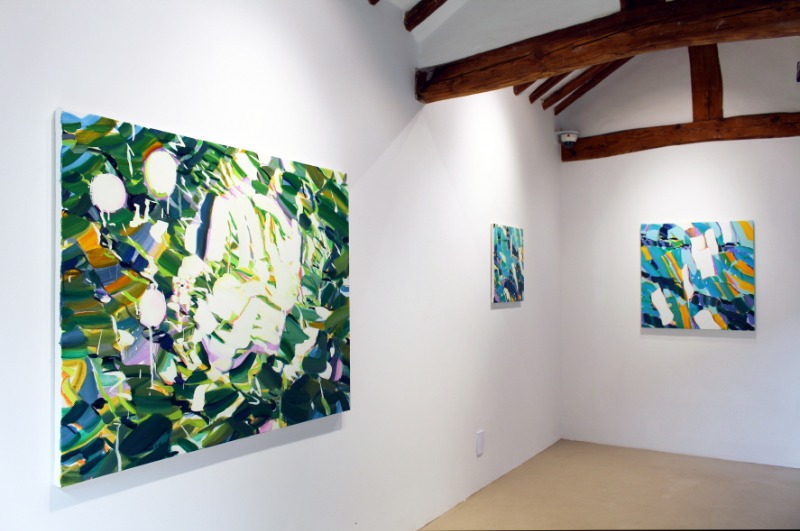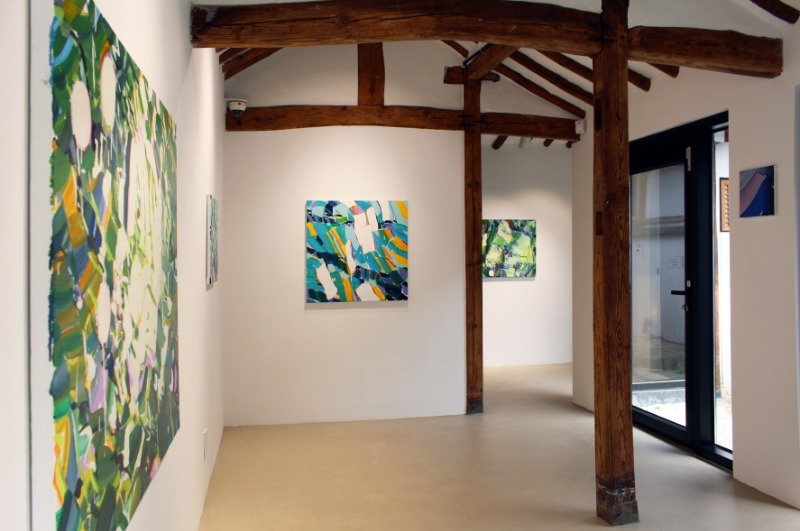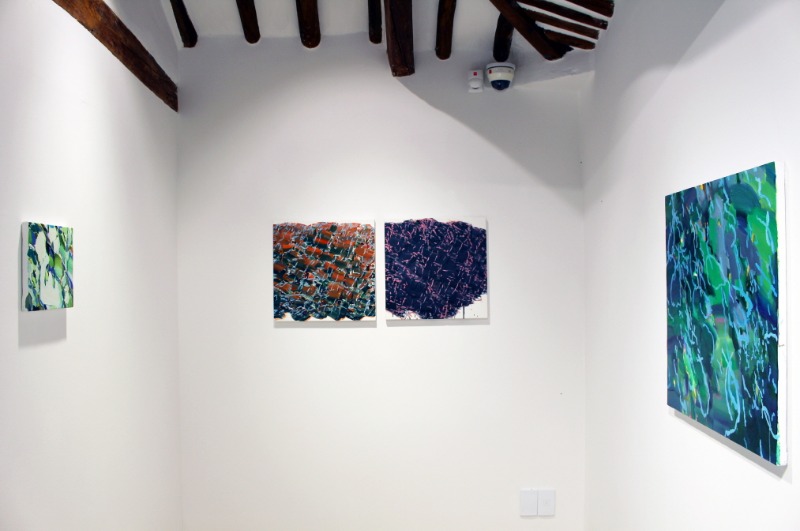
| Period| | 2020.07.08 - 2020.07.29 |
|---|---|
| Operating hours| | 11:00 - 18:00 |
| Space| | Hakgojae Design | PROJECT SPACE /Seoul |
| Address| | 22-3, Palpan-gil, Jongno-gu, Seoul, Republic of Korea |
| Closed| | Mon |
| Price| | Free |
| Phone| | 02-720-1524 |
| Web site| | 홈페이지 바로가기 |
| Artist| |
|
정보수정요청



|
|
Exhibition Information




The temporary size of a painting in excess of four corners. Ahn So-yeon | Art critic Let's talk about this painting, where the color side of a small square canvas with smooth brushstrokes catches the eye. The picture, which looks like it's filled with an object its form and a part of it, raises a lot of questions about how it was painted rather than the question of what it was painted. In other words, the visual impulse from uncertain perception of the surface of the painting precedes the visual compulsion that comes from not knowing what the shape of the painting is. <Upper Side of 'Myung Ui'>(2020) seems to have already forgotten what the original shape of the object itself was. What the title directs is "Upper Side of Myung Ui", but it evokes (only) a sense of a particular point in time and moment that perceives a part of the whole. The contrast of colors caused by the combination of two shades of color and the smooth texture of brush strokes toward the edge of the painting heighten the abstract sense to the fullest. Watching a figure appear and disappear from a well-organized square edge by visual compulsion to complete an incomplete shape like a hazy afterimage, you quickly fall into an abstract sense that maximizes the scene where you completely forget to find a hidden picturesque feature and stop as if it were a stationary screen of a moving image. Such awareness of the moment detected in <Upper Side of 'Myung Ui'> is in fact similar to the sensuous trigger he experienced in any place where landscapes and stills were viewed before the act of painting. Choi Yoon-hee has for some time shown a series of pictorial attempts to transform the visual experience gained fro m the night scenery into the act of drawing and the figurative implications of painting. He now looks carefully again at the time and space of "night", taking apart the conditions to enter the pictorial moments it has presented intensely. Among his other painting, The <Upper Side of 'Myung Ui'> belongs to a relatively small size. The <Upper Side of 'Myung Ui'> on the wall is clearly part of a shape - I don't think it's necessary to say it here - and because of the modular function that automatically reminds me of the organic structure of the colored surface supported by the canvas and the appearance of the square canvas, the impression as a small picture seems to presuppose incomplete uncertainty about the shape. However, Choi Yoon-hee does not prompt the quick retrieval of such illusions resulting from visual compulsion, but rather slowly reaches visual facts (after going through this procedure fully), and the modification and re-recognition of such visual experiences become possible by experiencing different senses of the size of the picture. For example, this small painting does not build the logic of forming a whole series of parts by extending its form outside the four corners or putting together puzzles, but merely displays a three-dimensional distance from the "me" that the figure in the painting had it reality. It is only one (original) image capturing a three-dimensional distance that suggests the possibility of gradual two-dimensional expansion and reduction. In other words, in the case of <Upper Side of 'Myung Ui'>, the size of the canvas is probably due to the visual distance that was placed in any place (by the pictorial moment) and the drawing of the plane is now able to reconsider the possibility of expanding and reducing the resolution of the brush strokes by using it as the original image. The emotions triggered by <Upper Side of 'Myung Ui'> from the tension flowing between the incomplete shape and the size of the obscure edge, and eventually stay in the abstract picture of the plane and concentrate on the visual impulse itself, which is absorbed in how it is seen. Choi Yoon-hee also showed interest in painting moments and visual impulses at the exhibition <Recording Pattern>(2019, OCI Museum) using her experience of night scenery as a medium. Close to 4 meters in width(2019) highlighted the problem of "size" in painting, leading to a series of <moving sculptures>(2019) and <Night on the Plate>(2019), <interval rhythm>(2019) series, which are smaller than that. He turned it into a conversational sense, noting that artificial lights twinkling in the darkness of the night hit boring rows of railings outside the car windows, creating a pattern of incessantly flat abstraction. Is there anything else as attractive as the night scenery? The surreal imagination that night exists as a stationary space without time has been incited endlessly, as numerous distortions, illusions, uncertainty and blurring increase the thickness of the night to its fullest. Choi Yoon-hee added time(movement) to the scene of the night to create a picturesque scene by tangling the surface of the night and casting it as it is. The flickering of artificial lights surrounding the deadly desolate night landscape and the movement of the gaze running across them eventually revealed the sense of space concealed by the uncertain thickness of darkness and captured the climax of the pictorial moment, buried somewhere in the air or retina by the moving gaze. And he seems to have tried to bring the moment of such an experienced temporary painting to just a sense of the superimposed image of the "time" and "space" using the color and quick brush strokes of the paint on a small paper board of 30 x 21 cm soon. The abstract figure drawn from the night landscape as an image of poetry and space is a complete transition to the experience of painting by forming one or two conditions of painting through the very "pictorial moment". At this time, Choi Yoon-hee seemed to drag distance and movement into a series of pattern/rounds to drag it to a reproducible size by gradually the drawing as the original(to the extent impossible) of capturing the sense of space and time, with the experience of time and space by the body already being converted into a conversational experience. In the words "Cutting the Spring," which he suggested as the title of this exhibition, I gave the title "a temporary size of a painting exceeding four corners." <Floating up, Recall> (2020)와 and <An Accurate View> (2020) clearly show the difference in size between 5 and 6 cm from each other, and the contrast seems to be a self-presentation of abstract shapes in which the size of the original can exceed the limits in anticipation of the dynamic force of the edges of the painting while strongly evoking the gradual expansion and reduction and reduction of the screen. Imagine that if the Health College, <An Accurate View>, were to gauge the face-to-face encounter at the moment of conversation, <Floating up, Recall> is to remind you of the repeated conversational experience after establishing conversational conditions. In <Weightless Motions> (2020) and <Coming Apart> (2020), more explicit movements can be thought of based on the same imagination. Choi Yoon-hee took note of the surface of the water on behalf of the past night scenery, capturing moments of temporary movement in the "light water" in which waves, as he put it, were swaying. As for the moment when his body and his sleep, which have become lightened by a temporary movement in a familiar place, exchange a sense of chance in one space and time, Choi Yoon-hee explores the possibility by examining a series of processes in which such small events are transformed into conversational experiences in the face of conversational moments. These captured light movements are transformed into abstract paintings with a sense of weight, size, direction and depth through a process of contemplation that moves away from the time and space of the event and adjusts the pictorial sense. At some point he, in particular, shows his willingness to be conscious of the possibility of a conversational experience that would exceed the framework of the archetype that captured the pictorial moment by engaging in the molding of this abstract nature. <Ascending Rhythm> (2020) and <Shifting Places> (2020) are temporary formations found on the surface of the water, which represent Choi's unique empirical perspective, such as the previous <Weightless Motions> and the <Coming Apart>. Just as the wind-swept waves of water, which had heavily sealed the depth below the surface of the water, transformed it into a lightly floating "movement" that soon rose and evaporated, he moves it to the abstract dimension of painting. On the other hand, if you look back at <Upper Side of 'Myung Ui'> with <Going up and down> (2020), the timing and distance these monotonous shapes imply particularly the mobility of some abstract formations. In this painting, in which the features of a spring structure are at first glance overlaid, its ascending and falling motility is newly constructed without emphasizing the shape and actual orientation of an object at an exceptional point. In this sense, the <Upper Side of 'Myung Ui'>also doubles the mobility of the screen even more, with careful brush strokes painted evenly with lines sliding from the abstract figure captured by this point, regardless of what the original form was, and the ambiguous mix of pink and blue overlapped in the process. Then, what is that little paper picture? Choi Yoon-hee's new attempt of paper draws many questions. What conversational goals can all these circumstances co-exist with: arbitrary irregular forms, the size of which seems to have fallen into parts, and the specific language (title) that directs them? As he has been preoccupied for some time, he has shown an attempt to express abstract visual impulses by taking a moment's explosive experience of artificial light strongly illuminated in the night landscape and expressing an abstract visual impulse, revealing a sense of distance maximized in the sequence, the identity of that little paper painting floating in the air cannot help but ask "where it comes from". In light of the circumstances, a number of clues come to mind, such as <a chair with four handles> (2020), <a walking position> (2020), <a heavy barrel, a dirty barrel> (2020), <a hot ring> (2020), <When the wind passes>(2020), and <See only the left side> (2020). Like a temporary scene created by artificial light in a night scene, Choi Yun-hee captures a temporary-sized figure from several scenes in the landscape in a series of small paper paintings. He captures a momentary scene in which, by light, by shadows, by overlapping forms, by motion, by various conditions in the background, features of any temporary size are experienced. It refers to the present state of "I" and the "size" in which the figure physically experiences, seeking autonomy for the temporary-sized features that include a kind of distance in the original. The ins and outs of the painting by <Things that Come from Somewhere> (2020) encompass a series of discussions. The abstract sense trained by the painter himself helps the pictorial experience of the source of this abstract figure through the visual impulse of what is seen and invisible, what is expressed and what is not expressed in the process of drawing. [Source] hakgojae design hompage
